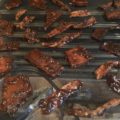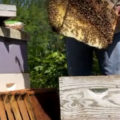I got together with a beekeeping mentor to make up some OA shop towels for combating varroa this season. The following is based on the research Randy Oliver is doing using OA, glycerin, and water mixed up to a certain volume and absorbed into rolls of Scott Shop Towels. While this method of OA application is not yet an approved method of application to honey bee colonies in the US, Randy is working with the EPA to get the method approved. The results Randy reported are pretty compelling, so we wanted to make some of these up in preparation to test out this season.

We know that OA vaporization and dribble are both effective methods for knocking back phoretic mites (mites on the bees). Unfortunately, neither method does anything to the mites in the cells which as we know are upwards of 50% of the mites in the colony. In addition, due to the short-lived presence of OA in the hive after these treatments (1-2 days), several follow-up treatments are needed in order to expose upcoming generations of mites to the OA when they come out of the comb. We’ve found that the variation in timing could allow enough time for a mite to come out of one cell and go into another before the next treatment, making vaporization and dribbles less effective as long as there is brood present in the hive.
The idea behind the saturated towels is to keep the OA present in the hive over 30-40 days (about the same length of time as other treatments) while it takes the bees that long to chew and tear up one full towel to get it out of the hive. As they do that, they spread the OA around the hive making it difficult for emerging mites to avoid contact. The fact that the beekeeper doesn’t have to go back into the hive to remove it is a bonus. This method of application can also occur while there are honey supers on the hive.

It’s important to understand there is a calculated amount of OA added per towel. This information can be found on Randy’s site, but I’ll list it below as a basis for what I would build on as I better understand the practicality of this application. Randy has asked any beekeepers who have ideas for improvement to let him know so we wanted to give it a try to see how this process could work if a beekeeper had to treat 100 hives in a given fall.
We don’t want to get Oxalic Acid in our eyes or on our skin. So, put on your safety glasses and nitrile gloves. The glycerin is really sticky as well. Also, have a bowl of warm water with some baking soda in it along with a cleanup towel handy. Baking soda will neutralize oxalic acid.
Make sure your roll of towels is cut in half. The following mixture is for a half-roll of towels.
Measure out:
- 336g OA crystals
- 364 mL food-grade glycerin
- 140 mL water

The water helps the towels absorb the solution better. Add the water to the glycerin and heat on the stove to about 140-160F. No need for any hotter. Once the solution reaches, 140F, add the OA crystals, stir with stainless steel spoon until the solution runs clear. Remove from the heat. Preheating the roll of towels a little in the microwave also helps the towels absorb all the solution. A minute in the microwave works fine.
Drop the half-roll of towels into the solution and allow time to absorb as much solution as it can. Ideally, it will come up the roll about halfway. Use a pair of tongs to flip the roll and allow it to absorb the rest of the solution until the entire roll is saturated.
Once done, allow to cool and dry. It will not dry out completely. The water will evaporate out, but the remaining glycerin will keep it oily to the touch. You can store the roll in a ziplock bag until use.
On full towel (or two half towels) is a single treatment for a colony. Place the towel on the top bars of the frames and close it up. I’ll update this post again later when I have some results.













Leave a Reply